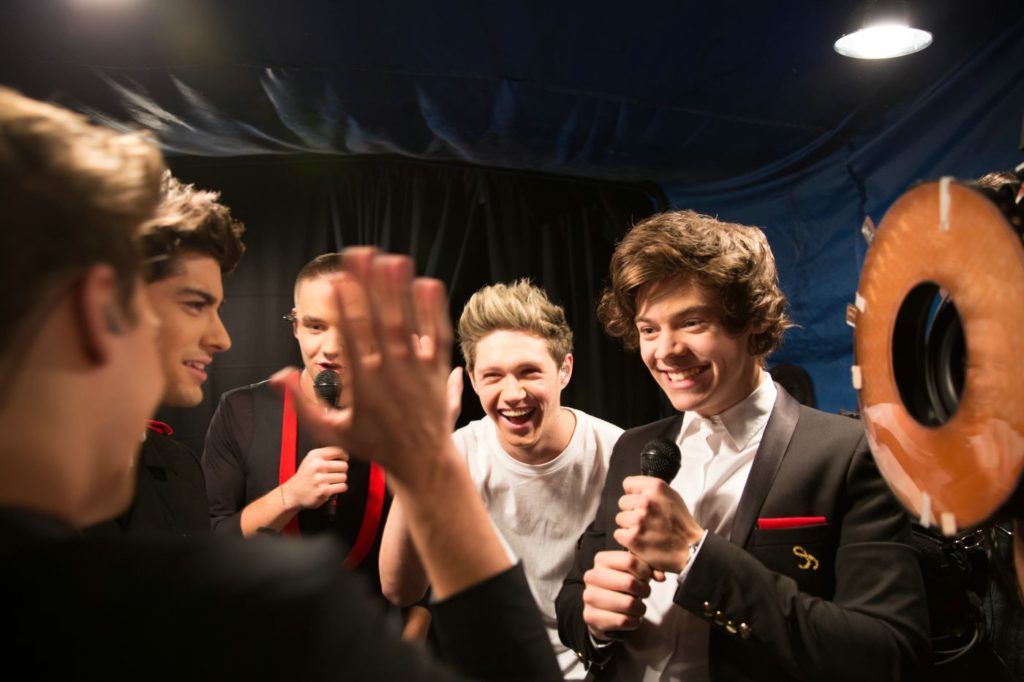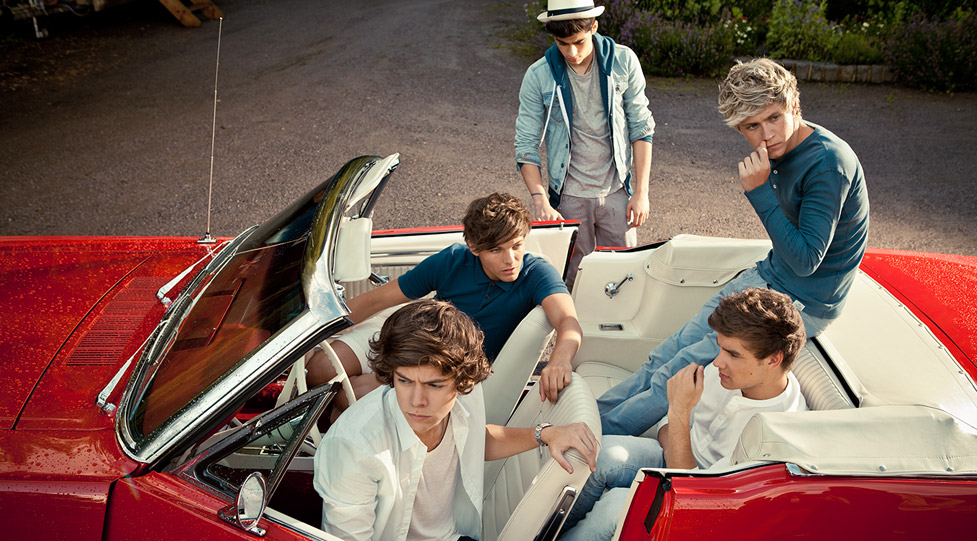Like Today’s Music Industry, This is An Exercise in Style Over Substance.
Director: MORGAN SPURLOCK/2013
 Being that One Direction is a boy band from Great Britain, I am quite sure that the audience for this film will be very limited. That being said, from what I saw at that screening for this film, that audience will be very large and highly enthusiastic, made up mostly of young girls aged 12-15, who will tweet, tumble, and Facebook their desire to see their favorite band on the big screen. Fortunately for One Direction, these type of fans will also bring their friends.
Being that One Direction is a boy band from Great Britain, I am quite sure that the audience for this film will be very limited. That being said, from what I saw at that screening for this film, that audience will be very large and highly enthusiastic, made up mostly of young girls aged 12-15, who will tweet, tumble, and Facebook their desire to see their favorite band on the big screen. Fortunately for One Direction, these type of fans will also bring their friends.
One Direction:This is Us documents the beginning of this band from their failed attempts to make it big as solo acts on Britain’s X-Factor. While each member of One Direction failed as solo stars on the show, producer/judge, Simon Cowell saw something in each of these young boys and decided to keep them on the show, only as an ensemble. While they didn’t win, they did gain a very impressive fan base that has now taken them global. They are expected to be the first billion dollar band by 2014.
Since they have only been around a few short years, this film serves to be more of a fan focused promo film for their upcoming 2014 tour more than anything else. One Direction: This is Us is directed by Morgan Spurlock (Super-Size Me, 30 Days, Mansome), who is no stranger to documentary films. Backed by Simon Cowell, who also has a producer credit, and who appears in the film, this may be the biggest budgeted Spurlock film to date. In 3D, Spurlock is able to delight fans by bringing the live stage show to life in a way that wouldn’t be experienced by the concert-goer.
And while I have no interest personally in this band, the production of the film was strong enough to keep me engaged in their short journey. Lacking any major meltdowns, addiction, or inner-band conflict that would normally accompany a film like this (or any episode of VH1’s Behind the Music), we are given their parent’s perspectives, complete with family photos and home videos of the One Direction boys when they were much younger, to make up the time. Some of the footage provided by the parents was even 5 years old, dating back to the mid-2000’s! (insert sarcastic tone)

But all joking aside, these guys should not be blamed for their youth and inexperience. They are obviously having a great time. And this is a symptom of what is lacking throughout this entire film: depth and perspective. One Direction’s initial fame was based on image. Their image earned them fans in Britain who called into the X-Factor to keep them going each round. When they lost the contest on X-Factor, Cowell, who saw their rabid fan base, capitalized on that by instituting a social media-driven marketing campaign that has enabled them to take their appearance on a popular TV show and has leverage it into successful recordings and tours.
Again, this image driven fame is not the fault of Niall, Zayn, Liam, Harry, and Louis of One Direction. But without the perspective of what it takes to create something from scratch, and claw your way out of the obscurity of your parent’s basement, garage, etc., they come off as just another bunch of kids enjoying the ride while the industry squeezes them for all their worth before replacing them with the next big “thing”.
While I was watching this film, I kept thinking about this reality. Morgan Spurlock has crafted a very slick film that will serve Simon Cowell’s marketing interest of One Direction perfectly, but he has failed to provide any narrative within the documentary that exposes the darker side of the music industry and how they capitalize on young bands such as this. You never experience any tension for the band, as we are not allowed to see any real struggle, other than exhaustion from how busy they are.

Cameron Crowe’s 2011 documentary, Pearl Jam Twenty, was masterful in that it embraced the fans of the band Pearl Jam, but also asked deeper questions of all involved. The narrative it put forth allowed it to reach out to those who weren’t fans of the band. Pearl Jam came off better by the end of the film because we saw them wrestle with the hard questions, and painful experiences, and so despite their flaws, they earned new fans through the film. It wasn’t built to hype, but to chronicle. One Direction: This is Usseeks to keep the veil over the darker truth of this industry, as it relates to One Direction, and so the band comes out of it looking like they are still immature boys with no bigger aspirations than gaining the wealth that comes with their fame. I don’t believe they intend this, but the glossy portrayal of this movie, traps them unintentionally in this box.
History is littered with other such acts that were here and gone in under 5 years, cast aside by the very industry that championed their rise. New Kids on the Block, 98 Degrees, ‘N Sync, and the Backstreet Boys, are some of the more known groups. Some of them, like Justin Timberlake or Donnie Wahlberg for example, were able to spin on to other things. And as nostalgia comes around every 20 years, many of these bands have been able to mount new tours and singles. But this dark side remains.
One Direction:This is Us has about 5-10 minutes of footage that actually addresses anything remotely relating to the hazards of where One Direction finds themselves. Band members actually address the “what if it all ends” question briefly, but then Spurlock redirects the momentum of the film back towards fun and the big circus that exists on the road. There are plenty of scenes of the boys delivering solid vocals and pop hooks throughout the film, and so I was pleasantly surprised to actually enjoy some of their talent. More than the stage talent, This is Us failed to really demonstrate their ability to write their songs, and see what inspires their creative process. Spurlock could have easily followed the documentary path of either Pearl Jam Twenty, or the Sigur Ros documentary,Heima, to allow this side of the band to be brought to the forefront.
The average One Direction fan, based on the screening, will either not see the film’s failures, or will disregard the lack of depth of This is Us, and instead scream till their heart’s are content from seeing these 5 heartthrobs singing to them, playing around, and “just being cute”.

To give you an idea of how much screaming may ensue, while waiting in line to enter the theater, the theater employees ushered in a life-size cardboard cut-out of the band for the fans to take their pictures with. When this happened, over 100 screaming fans were crying, clapping, and jumping up and down. It was so loud, that before I knew what was taking place, my first instinct was that the band had actually been brought in to screen the film with us.
Much like the experience of one of the original boy bands, The Beatles, the screaming throngs of fans make it near impossible to actually hear what is happening on stage, or in film, for that matter. So if you are not a fan already, I don’t think One Direction: This is Us will entice you to throw down $10-$15 dollars to see a movie on a Friday night. That being said, if you happen to choose a different movie, you will still hear the screams of the adoring fans who are watching it three screens over.
One Direction is a massive force in today’s pop landscape, and this film will serve to embolden their fans to stay on board for the upcoming year or so. It will fail to do much more than that. As Lester Bangs said in Almost Famous, “art accuses you”. It forces you to wrestle with its meaning, its impact on the world around you, and what you are going to do about it. One Direction: This is Us, sadly is not good art. It will not accuse you. It is however, a little entertaining, if you can hear it over the screaming wave from teenage fans.
Like the industry it is born from, this film definitely highlights style over substance.


